There needs to be a change to the dynamic of any training in the areas of total fitness from a classroom environment to a gym or field environment to initially bring people together for something they’ll care about. So for starters, put together regular PT sessions for your team/section/unit. This doesn’t have to be a huge endeavor and only needs to include an amount of people you can regularly sustain influencing to work out routinely.
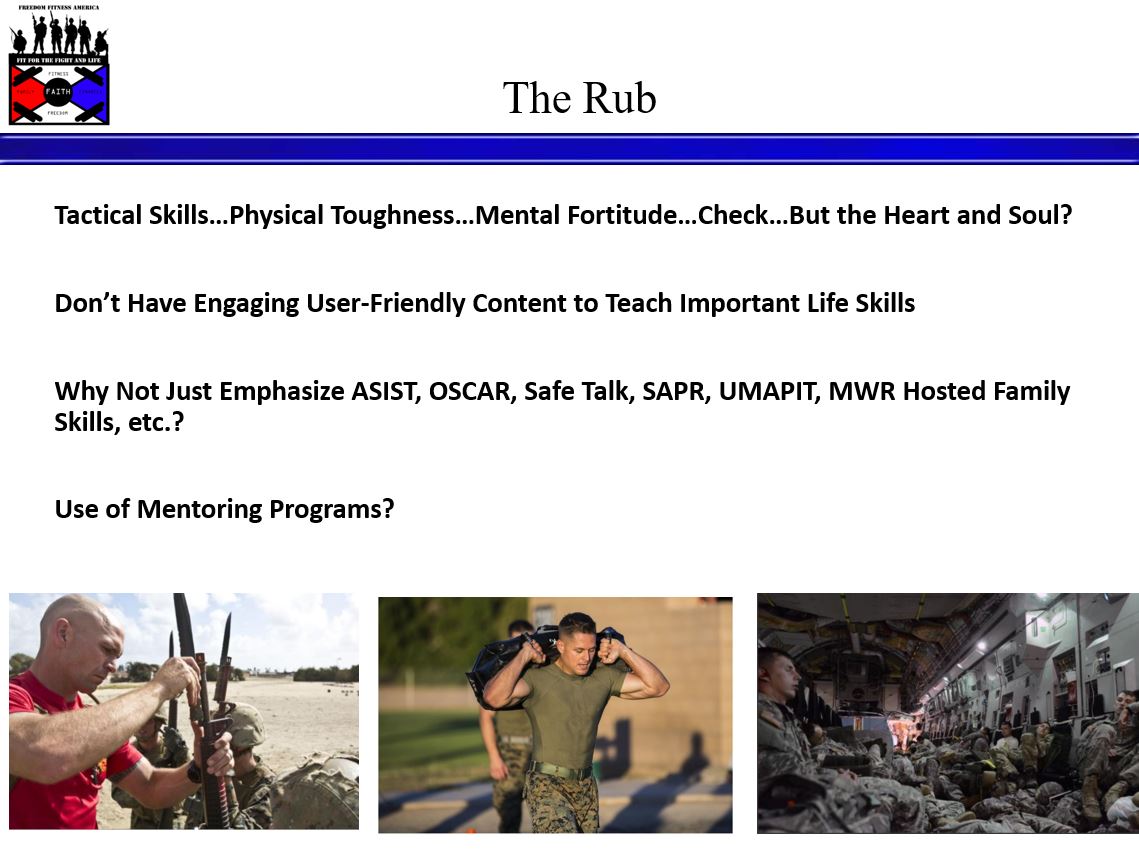
Alright, after my last blog post discussing multiple obstacles to military total fitness on a practical level with some light shed on exceptions to the rule, you might be thinking, "I kind of get the importance of emotional and spiritual wellness, but to be honest, that is too touchy-feely for me and probably most of the rest of the men and women around me except a few are even inclined to care about these areas." Why should you even care? Maybe you don’t really understand how to articulate this area and to be honest, you're not sure even if your chaplain or unit psychologist can articulate it in a way that resonates with everyday military professionals…everyday warriors in the trenches. If your people need some spiritual fitness then maybe you feel as if you've accomplished the mission by telling them to make an appointment with the chaps or a counselor on base, head to a weekend religious service at the local base chapel, get out and walk their dog, or get outside into the outdoors or something.
Another issue you might have been thinking, ok, so I have seen the value in setting up classes with experts on base for a PME say on finances, relationship skills, mindfulness meditation, etc. but I have to be honest, most of the content is not all that engaging and even if it is, it might be a bit weird, and the truth is the speakers generally don’t have the relatability to connect with everyday military professionals other than being experts in their fields and the buy-in only goes so far. Furthermore, I would love to see my heavy hitters teach this stuff, but the truth is, it is hard to put together a class on these types of issues unless they have personal experience or passion in any of these areas, and those are generally the exception, not the rule.
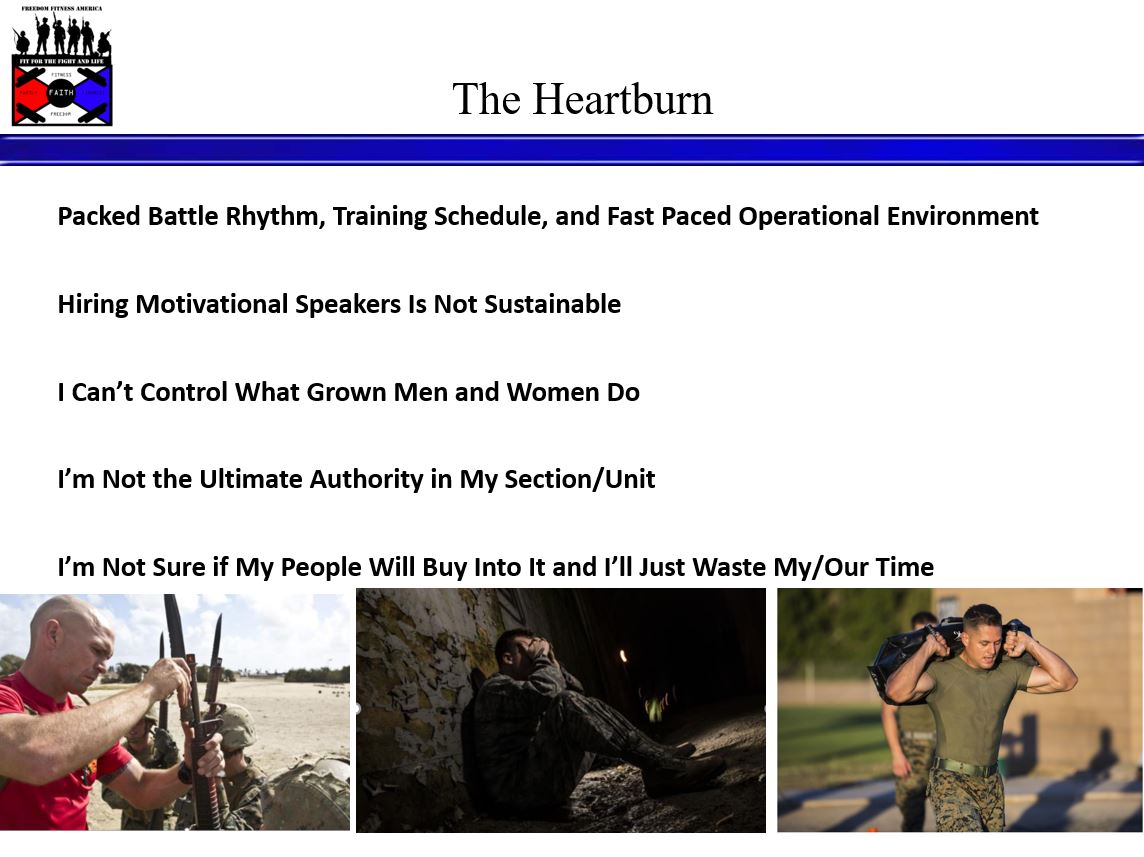
Ok, so maybe your next thought is we already have all this annual training like death by PowerPoint back in the saddle annual training, computer-based modules like Uncle Sam’s OPSEC, and other high-speed classes like ASIST, OSCAR, Safe Talk, SAPR, UMAPIT, CREDO, Strong Bonds, etc.? Shouldn’t I just send more of my people to these courses? With these issues in mind, you might be tempted to find a quick solution and just emphasize more the plethora of various training programs that chaplains and specialists to include some NCO/SNCOs/officers get tagged to lead as collateral duties. Shouldn’t we just get more people trained in these programs? Wouldn’t that make a difference? Isn’t it that simple?
Here’s My Response: The main four problems with these training programs are as follows:
One. They teach skills for individuals on how to react/respond to crisis/trauma either for themselves or their friends vs. proactively prepare men and women to teach them the right mindset and skills to cope with the issues before “boom” occurs in the first place. In other words, let’s take the issue of military and veteran suicide for example. Wouldn’t it be better to train and develop the right mindset, behaviors, and fortitude necessary for individuals to forego suicide in the first place? Don’t get me wrong, I think it is crucial to train individuals on how to help their friends, but let’s start way before “boom” happens. Reduction in suicide ideations vs. just measuring how many suicide intervention classes should be your measure of effectiveness.
Two. They typically are taught as a one-off training event either as an annual refresher or special weekend. This is kind of like thinking that you can get out and train for your Physical Fitness Test once or twice a year. Unless you are genetically gifted, that plan isn’t going to work too well for you.
Three. There generally is not a follow-through of trainers to continue to pass on their knowledge inside their work sections/units at the lowest level. Thus the education, experience, and training get bottled up with only a handful of people. The focus is on stopping behavior vs. changing thinking in the first place that leads to negative behaviors. In other words, change the root thinking or issues that led to the fruit behaviors or environment.
Four. These type of classes are generally taught by “outsiders” to the everyday military professional such as a chaplain, psychologist, MWR/government civilian, or another military professional with knowledge on the subject area but no day-to-day connection with the target audience such as one of their peers or senior leaders directly in their chain of command.
Ok, so in response to my above points, you probably recognize and have heard the drumbeat about the importance of “kneecap to kneecap” discussions, mentoring and counseling, getting to know people, etc. I’m 100% in agreement with you on that. In practice, though this typically looks like an initial performance counseling and performance counseling. After that, it is ad hoc with no standardization from my personal experience in everyday military life.

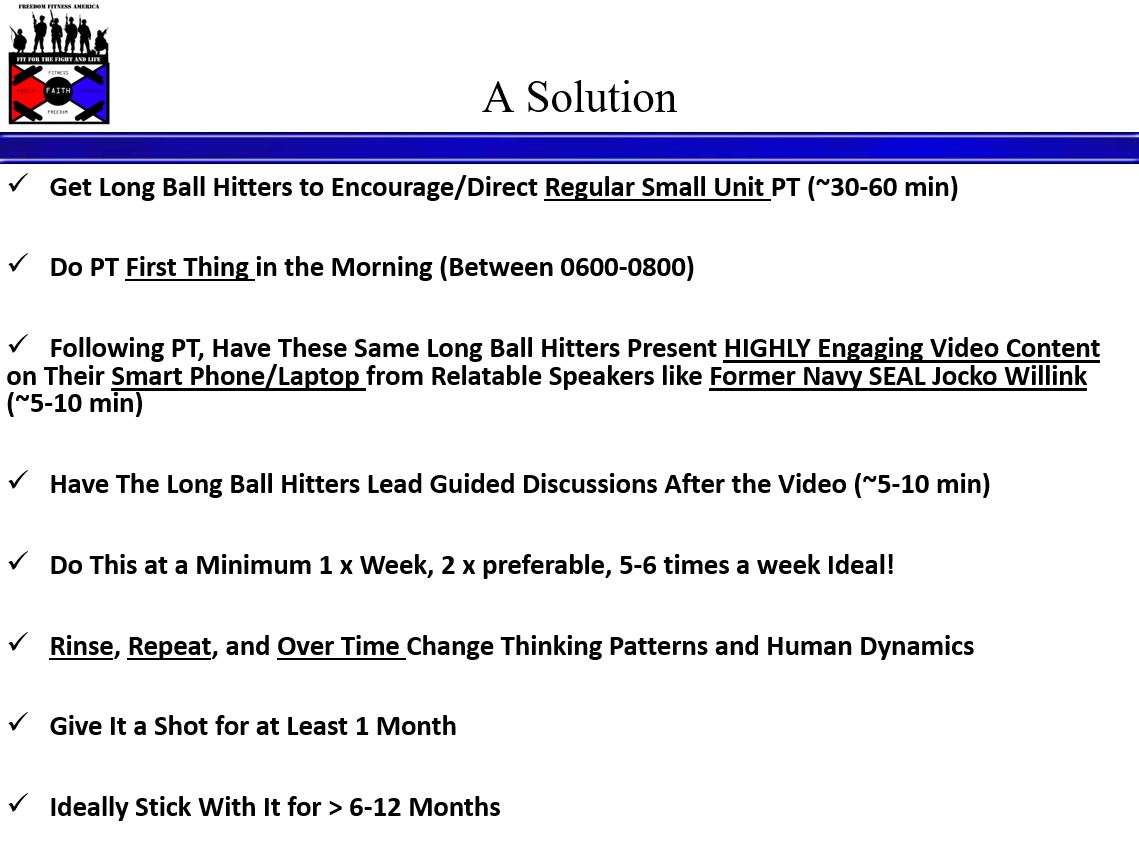
1) An observation that I've made is that from the very beginning of military training long before service members raise their right hand, physical fitness evaluations and training are at the foremost of activities that all service members care about. Furthermore, it is the most common day-to-day activity apart from eating and drinking during normal day-to-day activities.
Culturally it is one of the most popular motivational team-building activities that a unit could do together with a small amount of effort.
So to start with, there needs to be a change to the dynamic of any training in the areas of total fitness from a classroom environment to a gym or field environment to initially bring people together for something they’ll care about. So for starters, put together regular PT sessions for your team/section/unit. This doesn’t have to be a huge endeavor and only needs to include a number of people you can regularly sustain influencing to work out routinely.
2) Second, when conducting said name PT, host it in the early morning hours. Maybe not zero dark thirty, but before the unit’s battle rhythm gets busy, sometime between 0600-0800 is the sweet spot. 30-60 minutes of a good functional fitness PT session done in a competitive fun manner where people are pushed physically and mentally by each other naturally will build unit cohesion relationally while also maintaining the physical performance and health of your team. The best practice is to enlist the help of your heavy hitters, you know the highly charismatic NCO/SNCO or officer who is a PT stud/studette who can make it happen.
3)Third, following PT, have these same long ball hitters present highly engaging video content for about 10-15 minutes on their smartphones or laptops from highly credible/relevant/relatable motivational speakers like Jocko Willink, a combat-proven retired Navy SEAL leader who is highly respected in the military/veteran/high powered business world. Jocko has a large following of almost 1 million people on his PODCAST as he touches on military and leadership topics or interviews other credible military people on topics ranging from money, family, mental and emotional health, facing death, etc. I say video presentations are important because most military professionals today are millennials or generation Z and are used to consuming video content. I say smartphones because almost 100% of people these days have smartphones they can easily whip out and present content with maybe the assistance of a blue tooth speaker they already have.
4) Fourth, following this video presentation, have these same long ball hitters ask simple questions like, “what did you take away from that”, do you agree/disagree and why, what can you relate to, and what is the application for yourself or others? The discussion leaders should have watched the video ahead of time ideally and be familiar with the topic with some feedback of their own to share, but the point is not to pontificate but let the group share ideas because the ideas stimulated from positive content will start to change bad thinking into better thinking, reinforce positive values, and change the mind/heart/soul to have better outcomes for the future. For example, let’s say the topic is understanding collectively that bad things are going to happen to good people, focus on what you can control, not what you can’t, then this thinking will reinforce during difficult times these same thoughts to cope with the issue.
5) Do this at a minimum of 1 x week with your section say on a Thursday (end of the week) when battle rhythm events are typically light, preferably 2 x week, and more being even better! By keeping these touchpoints short but consistent over the long haul these events will add up. Rinse, repeat, and over time watch thinking patterns and human dynamics at play at work and in the personal lives of your people change.
6) Give this concept a chance to succeed for at least 1 month. I say that because experts say that it typically takes 21 days for neurons in the brain to change to form a new habit and get comfortable with it to become a regular part of your routine. Furthermore, disciplining yourself and your unit over this period will give you enough time even if you only do it for 4 sessions over 1 month to at least cover key topics that if nothing else will have planted a seed for that moment if you decide to discontinue. More than likely though, you will notice that your team is highly engaged during the sessions and they will want to continue the sessions because they are natural, engaging, and get to the heart of matters in the lives of military professionals. Over a period of 6 months to 1 year or more especially if this is done on a unit level, imagine how much change to thinking and culture could happen?

Now, there are many ways to provide a systematic form of holistic training that takes place during tactical evolutions, but the general methodology I have described above more or less has proven to be successful with various variations in different military units. Let's look at a few examples:
Example A: Leadership development video-based discussions were combined with small unit physical training with the 15th Marine Expeditionary Unit under the command of Colonel Clearfield. The chaplain who served under him reported to me that over the 18 months that they conducted this program, that they didn’t have one suicide and only 9 of the 900 servicemember couples represented by the command element and Major Subordinate Commands ended up going through a divorce. Talk about positive measures of effectiveness. During this program, sections were led by small unit leaders with the chaplain helping put together the content based on VADM McRaven’s speech to Texas A&M University in the beginning as the sections conducted PT and follow-on discussions. This training started in the workup and lasted through deployment.
Example B: A chaplain colleague of mine, Chaplain Kitzman, reported to me that a similar method was undertaken by a Special Purpose Marine Air-Ground Task Force in the Middle East that had dramatic effects in a similar proportion to the 15th MEU. This unit was suffering from many challenges to morale and disciple that the command could not get a handle on. Finally, in desperation, the Commanding Officer went to the chaplain who collaborated with fellow leaders in the unit to utilize the fitness/video discussion model that drastically turned things around to the point of major disciplinary and morale challenges seeming to be almost nonexistent in a short time.
Example C: Another colleague of mine, Justin Roberts, when he was the chaplain of the “No Slack Battalion” of the 101st Airborne Division, undertook discussion-based training on suicide prevention before his time when Safe Talk would come out. As a result, he watched a 70% reduction in suicides from the time of his unit’s first deployment to combat in Afghanistan to the time they returned from their second deployment.
Example D: In Headquarters Battalion of Marine Forces Reserves located in New Orleans, LA I helped to launch a total fitness program, this unit of approximately 800 Marines and Sailors suffered two back-to-back suicides in 45 days in the same section among other systemic challenges of substance abuse, domestic conflict, and sexual assaults. After working with the command's leadership, the chaplain reported to me that over a year’s time sexual assaults and suicidal ideations were reduced by 80% over the course of 1 year besides stemming alcohol and substance abuse.
Example E: As my last testimonial to this approach, I recently interviewed my fellow brother in arms, Master Sergeant John Rudd, USMC, an Explosive Ordnance Disposal Technician who served with the Marine Raiders. On the back end of losing his own mental, emotional, and spiritual balance through multiple deployments to combat back-to-back, he ended up rebounding from his time in intense counseling to teaching Marines coming up in the EOD Raider pipeline how to manage their lives as a whole in a manner that would keep them emotionally charged for the fights that lay ahead. He still teaches these principles to Marines he serves with. To hear his story, get your free access to Be a Boss on the Battlefield and Life now!
So now that we’ve described practical steps on what it would look like to implement total fitness in a unit, you are probably realizing that it will take some time to provide initial training, vet content, and have a simple way to disseminate it. At this point, it would be easy to get overwhelmed with everything else you have going on and just resort to well-worn but not necessarily effective training modes we have talked about before.
I don’t want you to go back through and want to see you and your team be successful, so I have gone ahead and put together an easy-to-follow system that is stupidly easy to follow, and yet will be deadly effective at delivering proven value. I call this system, the “Freedom Box”. As I mentioned before regarding the importance of taking at least 21-30 days to start a habit? Well, I would like to challenge you to a free 1-month experience of this system.
Essentially the “Freedom Box” is an easy-to-follow system designed to be implemented by military small unit leaders using resources available to them at no cost other than their own time. This system utilizes the aid of a CrossFit endorsed app called “Beyond the Whiteboard” that includes done-for-you functional fitness programming designed for warriors to achieve high-performance physical results, vetted videos related to relevant topics for military professionals on the job and in life, and follow the leadership training that your long ball hitters will find easy to follow. So if you are down to get after total fitness for yourself and those you serve with, then let me explain what you will get from this system more in the following paragraphs.
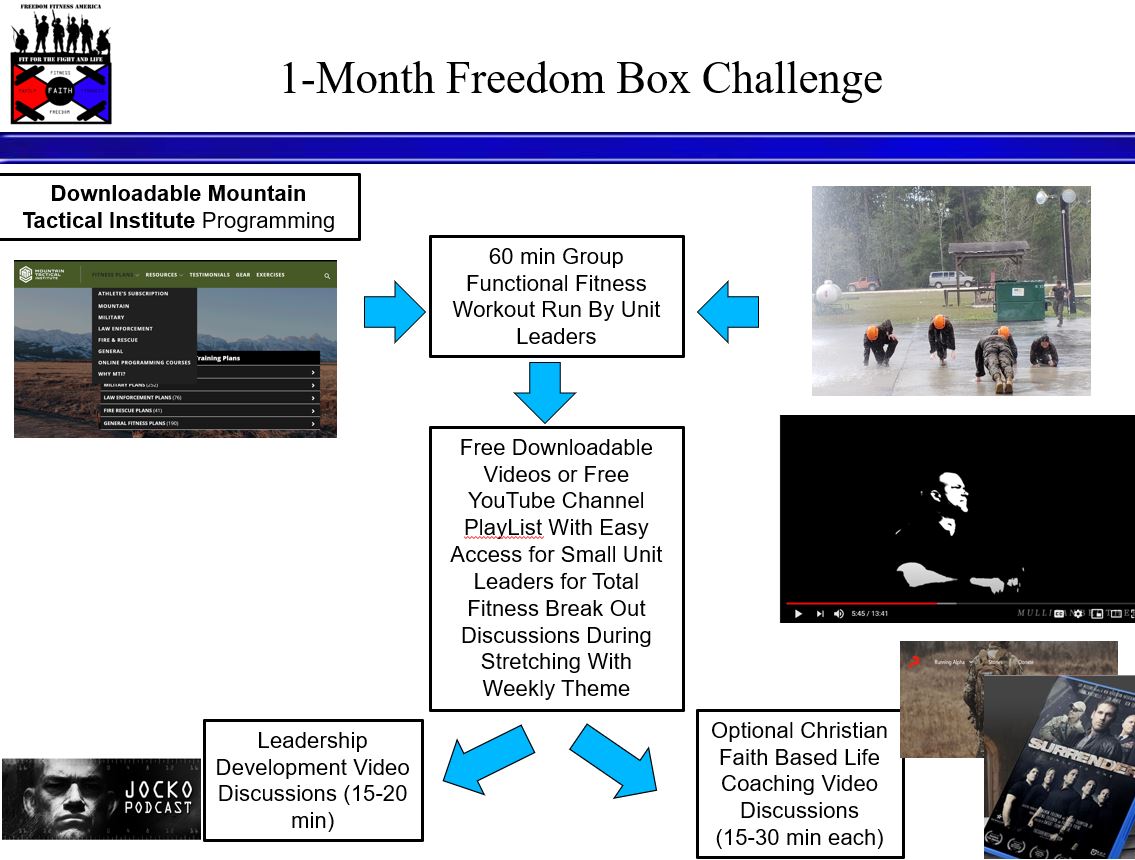
So what does the 1-month Freedom Box Challenge look like?
For one, you are going to get fitness programming workouts from the Mountain Tactical Institute that is shared via "SamePage" when you sign up for this program. Mountain Tactical Institute’s proven business model specializes in putting together functional fitness training easy for military athletes to get results of performance at the levels they need on and off the battlefield.
This will enable your long ball hitters to have readily available programming without having to produce workouts on their own. Your key leaders will be able to gain access to this app and programming to make it easy to set up group workouts with the equipment and spaces they have available to them.
Videos of difficult exercises will also be available in the app for easy show and tell to ensure that injury prevention mitigations are in place by proper training on exercise form. While the content over the course of a longer period will vary depending on unit needs, the first four weeks have been carefully chosen to have the greatest impact to quickly get buy-in and hit crucial areas of the warrior soul needed for units with people struggling to find answers to darkness on the battlefield and in life while also setting a foundation for key life skills.
Second, you will have access to videos you can download or access via YouTube that will allow for vetted, relevant, and highly engaging content related to the areas of physical fitness/nutrition/health, mental health and spiritual fitness, family and unit relationships, money, leadership, and finally ethical topics crucial to military operations. Speakers will include prior-enlisted turned Navy SEAL commanding officer Jocko Willink who is a well-known credible speaker and podcast host on military and leadership topics; Tyler Chittick, an active-duty USMC prior-enlisted officer who served as a Machine Gunner and is a CrossFit/fitness enthusiast; and content from a documentary drama highlighting the down and dirty stories of six US special operations specialists who participated in combat in the post 9/11 world.
Besides supporting general human performance training 2 x week as a start that you can mandate at a minimum in your units for up 30 min at a time, as a plug for the chaplain and to aid in the benefits of faith supporting overall spiritual fitness as previously mentioned, the Freedom Box app will also support supplemental optional faith-based video content to allow for multiple shorter discussions throughout the workweek for those interested in spirituality to develop their soul and life framework for the pressures of military operations and life. Military professionals who want to take part in the workouts but not the faith-based content discussions can certainly do so.
For full disclosure, the content provided is that of a Christian faith-based nature based on the leadership of Freedom Fitness America having a Christian faith background and expert experience in bringing this knowledge and experience to bear incredible solutions to issues common to humanity that can be a force multiplier in a unit. Furthermore, based on the religious needs of the unit and under the unit chaplain’s discretion and guidance as part of the Command Religious Program, other religious content not offered by Freedom Fitness America can be used as well in space made available for faith-based instruction.
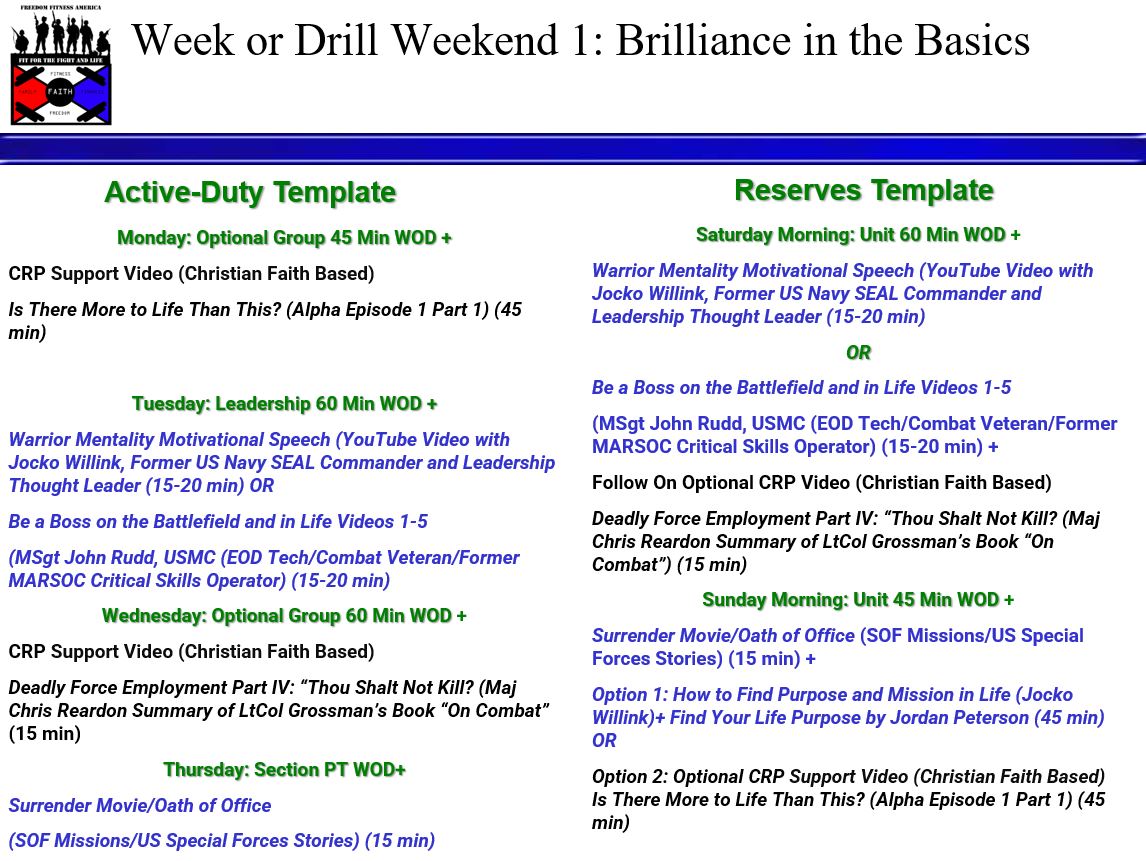
Looking at Week 1, Brilliance in the Basics”, highlighted in blue are the general topics that would be applied across the spectrum in unit training 2 x week. More can be put in potentially if units want to train to that level in terms of discussions following PT which may happen over time. For starters though, having 2 x week should hit the marks in terms of basic life skills and leadership development.
The faith-based content is highlighted in black. These are hard hitting topics that allow a chaplain the ability to arm lay leaders with this type of curriculum that is easy to use and follow in a similar fashion to the general leadership and life topics is crucial to building a command religious program that is relevant in an operational environment whether the chaplain is physically present or not.
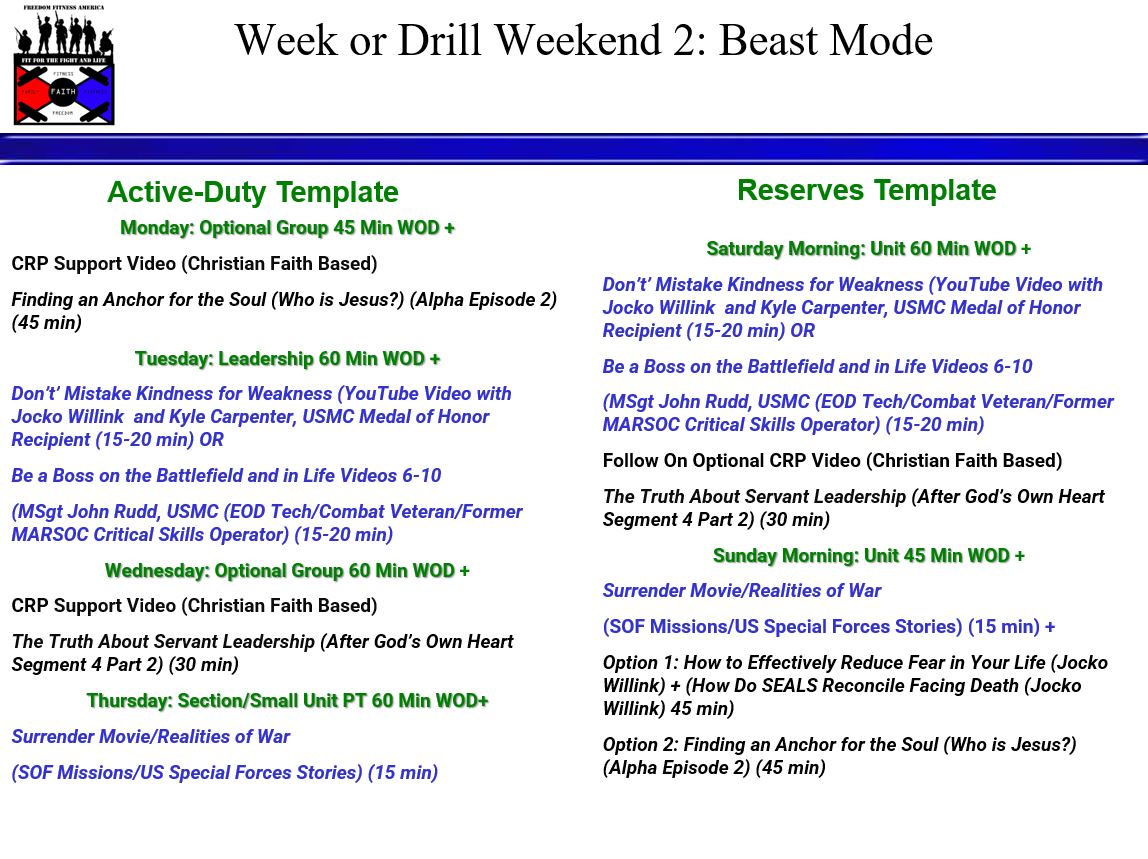
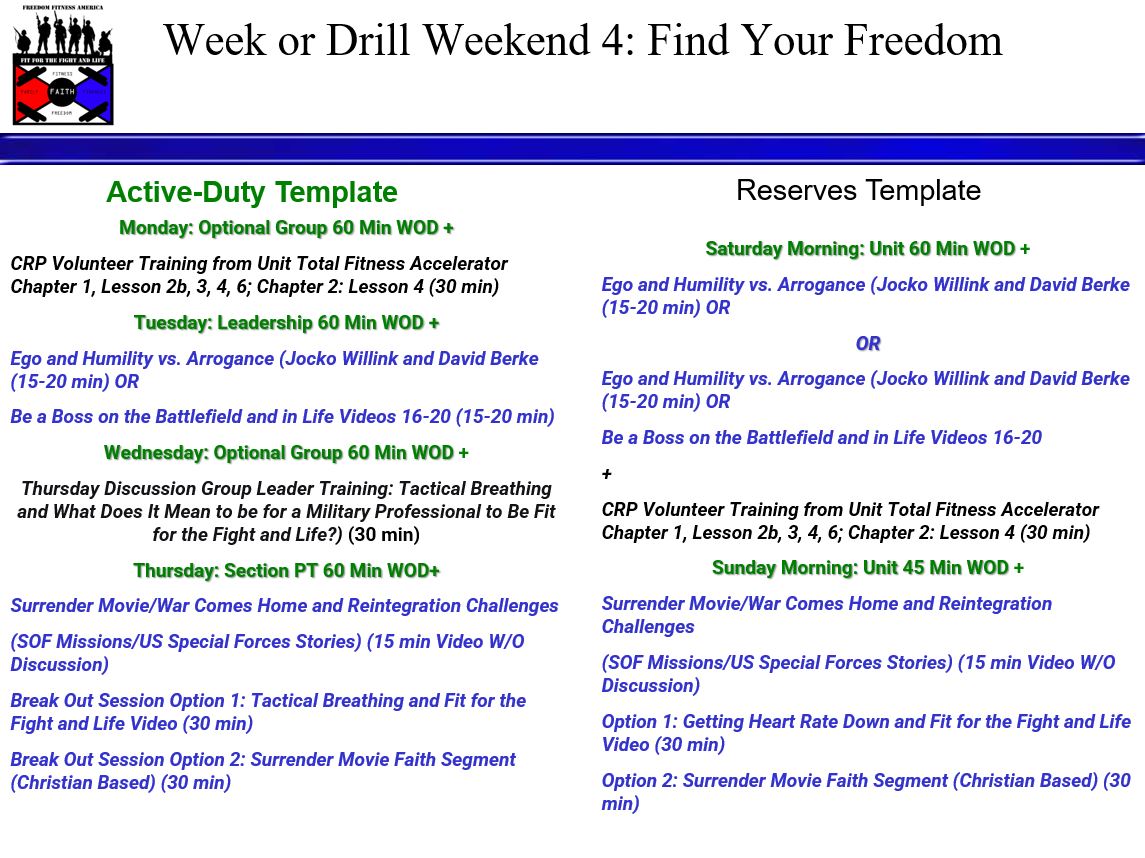

The curriculum from the “Surrender” Movie will be shown in bite-sized videos and 15 min segments throughout the month with the hope that every day there is something for units to PT and have a discussion on. The videos can be combined as well with fewer PT sessions. The overall movie is an overall documentary drama like a History Channel documentary related to 6 US Special Forces Operators telling their story which is acted out related to their lives in the post 9/11 combat world which includes the good, bad, and the ugly all around. Topics touched on will include combat and operational stress, transition issues, substance abuse, suicidal ideations, Post Traumatic Stress, and domestic violence. As a warning, this movie is heavy with emotionally difficult scenes based on the true stories of combat veterans who have been through hell and back.
The last day of this month's training will allow for two options of instruction. One option will be to focus on general solutions to understanding how to cope with the emotional aspect of killing on the battlefield, finding a work/life balance, understanding some pro tips to lead a team to victory on the job and in life, and tactical breathing. The second option will be optional participation in a Command Religious Program session that is Christian faith-based where the faith-based stories of the warriors told from the initial segments will be highlighted as solutions to overcoming the darkness of the battlefield and in life.
Aside from the content delivered for training, video instruction will be provided both in the app and through email for the unit chaplain and participating military leaders on how to set up and deliver the Freedom Box program to especially include administering the faith-based portions appropriately under the Command Religious Program. This will include access to Freedom Fitness America’s FREE 90 min video course called the Unit Total Fitness Accelerator highlighting practical steps to implementing an integrated total fitness program in your unit all the way to set up a large-scale total fitness event in your unit with ease.

Ready to take the challenge? Then register here to get started today!
Fit for the Fight and Life,
Chris Reardon
Major, USMC
Founder/Director of Freedom Fitness America